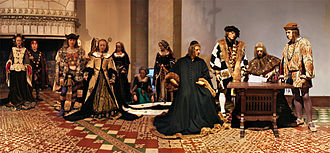- Château de Langeais
-
Château de Langeais 
General information Country France Construction started 10th century Website http://www.chateau-de-langeais.com/ The Château de Langeais is a castle in Indre-et-Loire, France, built on a promontory created by the small valley of the Roumer River at the opening to the Val de Loire. The tall fortified hall at the rear of the enclosure is thought to be among the earliest datable stone examples of a keep in Europe.
Contents
History
The Château de Langeais was originally built as a protection fortress in the 10th century by Foulques Nerra of Anjou
One detailed study has been done on the cost of construction of Langeais tower, built in 992. The stone tower is 16 metres (52 ft) high, 17.5m wide, and 10m long with walls averaging 1.5m. The walls contain 1,200 cubic metres (42,000 cu ft) of stone and have a total surface (both inside and out) of 1,600 square metres (17,000 sq ft). This tower is estimated to have used 83,000 average working days to complete, most of which was unskilled labour.[1]
Under the Plantagenet kings, the chateau was fortified and expanded by Richard I of England (King Richard the Lionhearted). However, King Philippe II of France recaptured the château in 1206. Eventually though, during the Hundred Years' War, the English destroyed it.
King Louis XI (1461-1483) would rebuild it into what today is one of the best known examples of late medieval architecture. It is especially noted for its monumental and highly decorated chimneypieces.
After nearly being totally destroyed during the Hundred Years' War, the chateau was rebuilt about 1465 during the reign of King Louis XI. Located on a cliff overlooking the Loire River, the Château appears dark and ominous, but the interior rooms are richly decorated.
The great hall of the château was the scene of the marriage of Anne of Brittany to King Charles VIII on December 6, 1491 that made the permanent union of Brittany and France. However, the fifteen-year-old Duchesse Anne, not happy with the politically arranged marriage, arrived for her wedding with her entourage carrying two beds.
In 1886, Jacques Siegfried bought Château Langeais and began a restoration program. He installed an outstanding collection of tapestries and furnishings and bequeathed the château to the Institut de France which still owns it today. The château is open to the public.
It is listed as a monument historique by the French Ministry of Culture.
Gallery
See also
References
- Mesqui, Jean (1997). Chateaux-forts et fortifications en France. Paris: Flammarion. pp. 493 pp. ISBN 2-08-012271-1.
- Bibliography
- Bachrach, Bernard S., "The Cost of Castle Building: The Case of the Tower at Langeais, 992–994", in Kathryn L. Reyerson, Faye Powe, The Medieval Castle: Romance and Reality, University of Minnesota Press, pp. 47–62, ISBN 9780816620036
External links
- Official website (French)
- Ministry of Culture database entry for Château de Langeais (French)
- Ministry of Culture photos
- Photographs of the Château de Langeais
Châteaux of the Loire Valley Amboise • Angers • Azay-le-Rideau • Blois • La Bourdaisière • Chambord • Chaumont • Chenonceau • Châteaudun • Cheverny • Langeais • Loches • Menars • Montreuil-Bellay • Montsoreau • Plessis-Bourré • Le Rivau • Saumur • Sully • Talcy • Troussay • Ussé • Valençay • VillandryCategories:- Châteaux of the Loire Valley
- Buildings and structures in Indre-et-Loire
- Official historical monuments of France
Wikimedia Foundation. 2010.





